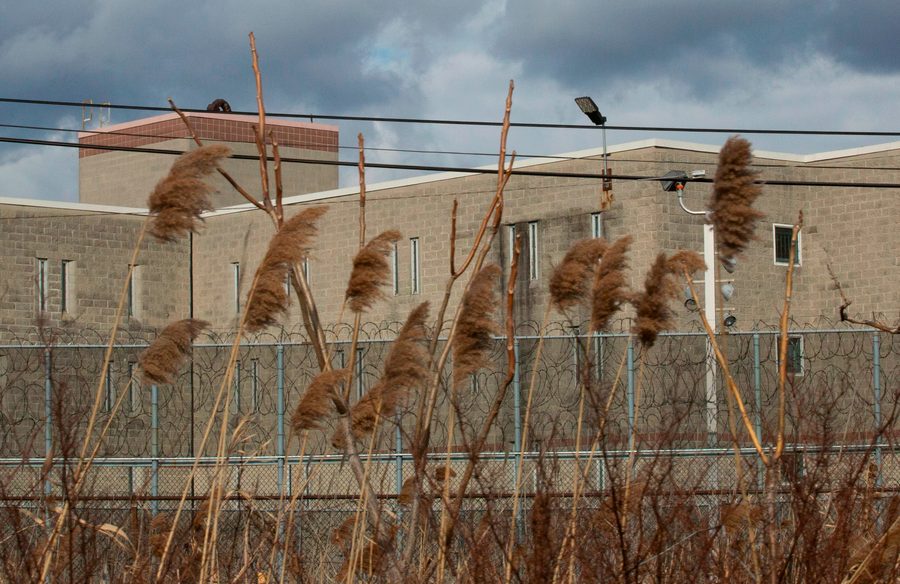When Climate Disaster and Mass Incarceration Collide
Failed responses to environmental disasters in jails are gambling with detainees’ lives.
Daniela Ochoa-Bravo

PALMETTO, FLA.— More than 1,200 detainees at Manatee County Jail waited to hear if they would be evacuated from the danger zone on April 4 as a breach in a nearby wastewater reservoir threatened to plunge the area under a 20-foot wall of contaminated water. What followed were 72 hours of uncertainty and yet another failed response to an environmental disaster that gambled with the lives and wellbeing of incarcerated people.
The breach was discovered on April 2 at the old Piney Point phosphate plant reservoir in Manatee County, threatening to collapse one of the walls holding back more than 300 million gallons of radioactive water. If this wall ruptured, it would take less than an hour for the county to be submerged under “a 20-foot wall of water,” Acting Manatee County Administrator Scott L. Hopes told a local news channel. The potentially “imminent” collapse of gypsum stacks full of toxic and radioactive contents would have been one of the largest environmental disasters of recent years.
The next day, Gov. Ron DeSantis declared a state of emergency in Manatee County and issued a mandatory evacuation order to “protect the lives and property of the people in the threatened communities.” More than 300 households were within the mandatory evacuation zone, and many fled the area, relocated by the local and state government to hotels where they received free meals. Detainees at the jail, meanwhile, were left neglected, just over a mile away from the Piney Point phosphate plant.
Local organizers tweeted an urgent plea for the public to flood with phone calls the offices of the Sheriff for Manatee County, Rick Wells, the Board of County Commissioners, and the Emergency Management Division at Manatee County, in hopes that the pressure would force officials to evacuate the incarcerated people. At first, the sheriff moved the medical unit and jail staff to the second floor of the facility, leaving detainees vulnerable to the consequences of the flood on the first floor, surrounded by large bags of sand that were allegedly placed there to delay the effects of the flooding.
By early morning on April 4, the sheriff had crammed as many inmates as possible into the second floor’s cells. Only 267 of 1,200 inmates were evacuated during the crisis, and they were sent to the nearby Polk County Jail.
Jordan Mazurek, an organizer with Florida Prisoner Solidarity (FPS) — an abolitionist collective whose mission is to prioritize the needs of all incarcerated people, their community, and “care networks” — fumed about Sheriff Wells’ response to the looming crisis. “The immediate excuse from the sheriff’s office for why they weren’t evacuating people was, ‘Covid. We can’t evacuate people because it’s not Covid safe.’ Well, keeping people in cages is not at all Covid safe.” In overcrowded cells, prisoners faced a greater risk of spreading Covid-19.
Detainees waited nervously to see if the breach would mean that a toxic flood would cut off all access to the critical infrastructure on the first floor, their water supply — or worse. Had the jail flooded, emergency access to the facility wouldn’t have been possible since the Florida Highway Patrol had already closed U.S. Route 41, the only road to the jail.
On April 6, the ACLU filed a lawsuit against Rick Wells and the state of Florida for presenting an “unreasonable risk of serious harm” to those that remained detained at the jail.
Thankfully, the crisis for Manatee County was averted by pumping millions of gallons of polluted water into Tampa Bay, providing reprieve to the detainees. But the gamble taken by the state of Florida and the sheriff carried large risks: When the evacuation order was lifted on April 6 — four days after the breach was discovered — more than 1,000 inmates remained at the jail.
On April 12, the lawsuit against Florida and Sheriff Wells and was dismissed by the ACLU.
For Florida Prisoner Solidarity, questions regarding the safety of incarcerated people during climate disasters are not new. The organization connected In These Times with an incarcerated person at a Florida prison that has frequently been threatened by hurricanes. The person asked to remain anonymous out of concern for their safety.
“They come with plywood and cover up the windows — this is when everybody just walks around in their box,” F.D.O.C. Slave, whose chosen pseudonym is a reflection of the abuse he has experienced while imprisoned in Florida, told In These Times with respect to preparations for incoming hurricanes. While F.D.O.C. Slave has not personally experienced extreme flooding at his prison, there have been many reported cases of severe flooding across the country due to the poor infrastructure installed, allegedly, to protect inmates, proving that plywood is not adequate protection for hurricanes. Though the plywood is typically installed two to three days before the hurricanes, “it usually takes two weeks” to remove them. If another hurricane is expected soon, prisons keep the plywood for up to a month, often during 90-degree temperatures in June and July. “Because there’s no AC, and they close all the windows… there’s no ventilation,” said F.D.O.C. Slave. Over 1,200 legal cases were filed from 1980 to 2019 that claimed violation of the Eighth Amendment right to protection from dangerous temperature conditions. According to Prison Legal News, 79 inmates and prison staff suffered from heat-related illnesses in the first 10 months of 2018.
Natural disasters, accelerated by climate change, are a growing threat to incarcerated people across the United States, who are vulnerable and often left behind during environmental crises.
Deidre McDonald wrote in a first-person account for the Marshall Project about being incarcerated in a Texas prison during Hurricane Harvey in 2017: “To get to the main building, I must wade into it, knee-deep. That’s when I notice the ladies with wheelchairs, walkers and crutches are struggling. One woman is crying hysterically because she is afraid of water, and the dorm boss can’t get her to take one step forward.” Her account calls attention to how lack of planning and infrastructure poses additional risks for prisoners with disabilities or phobias.
“Folks [were] up to their waist and chest in water for 12 hours,” Jordan Mazurek, an FPS organizer whose background is in toxic prisons and environmental justice, said of Hurricane Harvey’s devastating impact on Texas prisons. “The feds didn’t have enough water to go around and so folks started drinking toilet water because it was the only thing left, and as a result, two prisoners died of bacterial infections.”
The intersection of mass incarceration and environmental disasters is not coincidental. While the U.S. Environmental Protection Agency (EPA) states that no group should be discriminated against when considering the public’s right to live in hazard-free areas, there’s a clear link between unsafe environmental conditions and sites of incarceration. Frequently located on cheap undesirable real estate, nearly one-third of federal and state prisons in the United States are less than three miles away from a Superfund cleanup site — highly contaminated areas, also known as toxic waste dumps, that the EPA determines as needing long-term clean-up since they pose a risk to the health and wellbeing of either humans or the environment.
Marcos Santos, an inmate at the State Correctional Institute at Fayette in Pennsylvania — built on top of an old mining site and surrounded by “about 40 million tons of waste” —told Al Jazeera in 2016, “I’ve had to endure numerous medical problems: rashes throughout my body that hurt and keep me up all night. Extreme swelling of various parts including my throat making it difficult to breathe.”
Inmates are at the front lines of “the most brutal effects of every single disaster situation,” said Mazurek of FPS. Incarcerated persons’ lack of mobility makes it so that they cannot “move out of the path of a hurricane on their own free will or move out of the path of what would have been a 20-foot-high wall of toxic water coming at their jail,” Mazurek continued. “Prisons are just an ongoing disaster, and that’s how it’s going to be until we close them all.”
Daniela Ochoa-Bravo is a mixed-media artist and writer based in Brooklyn, who graduated from The New School with a major in Global Studies, and a minor in Ethnicity & Race. She is currently an editorial intern with In These Times. You can find her on Twitter @DanielaOchoaBr




